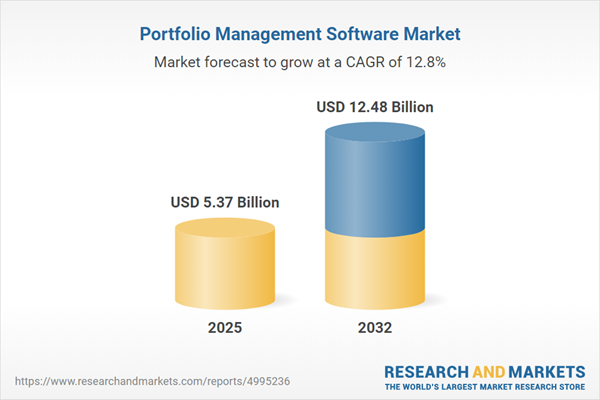Speak directly to the analyst to clarify any post sales queries you may have.
The Portfolio Management Software Market is evolving rapidly as enterprises prioritize cloud transformation, advanced analytics, and client-driven innovation. Senior decision-makers must navigate a landscape shaped by regulatory shifts, rising data sophistication, and the ongoing push for operational efficiency.
Market Snapshot: Portfolio Management Software Market
The Portfolio Management Software Market expanded from USD 4.76 billion in 2024 to USD 5.37 billion in 2025 and is projected to reach USD 12.48 billion by 2032 with a CAGR of 12.78%.
Growth remains propelled by enterprise-wide modernization, digital ecosystem development, and adoption of adaptive, modular architectures. Industry players are recalibrating platform utilization to fulfill requirements for transparency, speed, and compliance within heightened regulatory settings. The integration of advanced portfolio management software is facilitating greater automation, better data orchestration, and more tailored user experiences across organizations globally.Scope & Segmentation
- Function: Solutions span Accounting & Reporting, Analytics & Forecasting, Client Onboarding & CRM, Investment Management, Risk & Compliance Management, as well as Trading & Rebalancing. Each function contributes to unified workflows that enhance both efficiency and regulatory adherence.
- Asset Class: The software accommodates Alternative Assets, Equities & ETFs, Mutual Funds, and Real Estate & REITs, enabling wide-ranging asset strategies and supporting diversified investor portfolios.
- Deployment Type: Deployment covers Cloud (including Private and Public Cloud) and On Premise, ensuring organizations can select architectures that align with security, scalability, and legacy integration needs.
- Component: Platforms feature Analytics, Data Management, Planning, and Reporting capabilities, addressing the core requirements of multi-asset and multi-region operations while ensuring cohesive data flow.
- Organization Size: Solutions are suited for both Large Enterprises and Small and Medium Enterprises, helping organizations of various scales standardize processes and improve transparency.
- Vertical: Key industries include Banking, Government, Healthcare, IT and Telecom, Manufacturing, and Retail, all benefiting from enhanced collaboration and greater data-driven insights enabled by portfolio management software.
- Region: The market demonstrates strong participation across the Americas (covering North America and Latin America), Europe (including major economies and the Nordics), the Middle East & Africa (with subdivided emphasis by country), and Asia-Pacific (spanning significant markets and emerging economies).
- Companies: Leading providers include SAP SE, Hexagon AB, Horizon Technologies Ltd., International Business Machines Corporation, Asset Panda LLC, EZ Web Enterprises Inc., BMC Software Inc., S&P Global Inc., Meisterplan by itdesign GmbH, BlackRock Inc., and SimCorp A/S.
Key Takeaways
- Enterprises are accelerating the shift from legacy on-premise setups to cloud-native, modular platforms that support rapid application integration and adaptation to business change.
- Centralized data management enables real-time analytics and deeper asset visibility, supporting both long-term and short-term decision-making across all asset classes.
- Risk management and compliance are integrated into investment workflows, helping organizations respond to evolving regulations and higher standards from investors and clients.
- Client experience is prioritized through platform-enabled transparency, automation of manual processes, and greater personalization during onboarding and reporting tasks.
- Strategic differentiation, often realized through mergers, acquisitions, and alliances, is enhancing the breadth and security of service offerings as firms collaborate to deliver increased scalability and agility.
Tariff Impact and Procurement Strategies
- Tariff adjustments are influencing procurement policies by prompting organizations to revisit hardware investment, infrastructure refresh cycles, and deployment models, leading to increased consideration of cloud-based strategies and diversified supplier relationships to mitigate supply chain vulnerabilities.
- Shifts in cross-border regulations drive the need for greater flexibility in both contractual and deployment arrangements, empowering enterprises to remain resilient in the face of geo-economic disruption and to preserve critical investment operations.
Research Methodology & Data Sources
This assessment draws on expert interviews with technology and operational leaders, in-depth review of leading vendor documentation, regulatory filings, and public statements. Findings are validated using scenario-based approaches to ensure practical relevance across varying deployment environments and geographic markets.
Why This Report Matters
- Enables C-suite executives to benchmark portfolio management software adoption and operational strategies relative to industry peers under evolving regulatory and technological conditions.
- Provides actionable insights into functional, organizational, and geographic segmentation, supporting informed decisions around platform selection, vendor engagement, and strategic roadmap planning.
- Equips procurement and risk leaders with guidance to address modernization demands, supplier selection, and tariff-driven risks within dynamic global supply chains.
Conclusion
Portfolio management software built on modular, data-centric frameworks gives enterprises the tools to turn regulatory and operational complexity into opportunities. By aligning technology choices with business priorities and local requirements, decision-makers can ensure enduring organizational performance.
Additional Product Information:
- Purchase of this report includes 1 year online access with quarterly updates.
- This report can be updated on request. Please contact our Customer Experience team using the Ask a Question widget on our website.
Table of Contents
3. Executive Summary
4. Market Overview
7. Cumulative Impact of Artificial Intelligence 2025
List of Figures
Samples

LOADING...
Companies Mentioned
The key companies profiled in this Portfolio Management Software market report include:- SAP SE
- Hexagon AB
- Horizon Technologies Ltd.
- International Business Machines Corporation
- Asset Panda, LLC
- EZ Web Enterprises, Inc.
- BMC Software, Inc.
- S&P Global Inc.
- Meisterplan by itdesign GmbH
- BlackRock, Inc.
- SimCorp A/S
Table Information
| Report Attribute | Details |
|---|---|
| No. of Pages | 185 |
| Published | October 2025 |
| Forecast Period | 2025 - 2032 |
| Estimated Market Value ( USD | $ 5.37 Billion |
| Forecasted Market Value ( USD | $ 12.48 Billion |
| Compound Annual Growth Rate | 12.7% |
| Regions Covered | Global |
| No. of Companies Mentioned | 12 |









